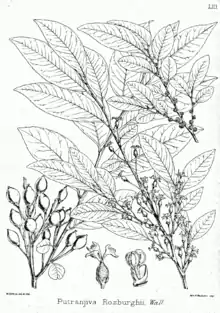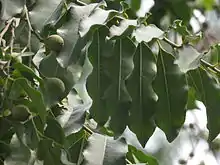Putranjiva
Putranjiva is a plant genus of the family Putranjivaceae, first described as a genus in 1826. It is native to Southeast Asia, the Indian Subcontinent, Japan, southern China, and New Guinea.[2]
| Putranjiva | |
|---|---|
 | |
| Putranjiva roxburghii[1] | |
| Scientific classification | |
| Kingdom: | Plantae |
| Clade: | Tracheophytes |
| Clade: | Angiosperms |
| Clade: | Eudicots |
| Clade: | Rosids |
| Order: | Malpighiales |
| Family: | Putranjivaceae |
| Genus: | Putranjiva Wall. |
| Synonyms[2] | |
| |
Along with Drypetes (of the same family), it contains mustard oils as a chemical defense against herbivores.[3] The ability to produce glucosinolates is believed to have evolved only twice, in the Putranjivaceae and the Brassicales.[3]

Putranjiva roxburghii seen in Hebbal Lake Gardens, Bangalore

Putranjiva roxburghii seen in Hebbal Lake Gardens, Bangalore
- Species[2]
- Putranjiva formosana Kaneh. & Sasaki ex Shimada - Guangdong, Taiwan
- Putranjiva matsumurae Koidz. - Honsu + Ryukyu Islands in Japan
- Putranjiva roxburghii Wall. - Indian Subcontinent (India, Pakistan, Bangladesh, Nepal, Sri Lanka), Indochina, Malaysia, Indonesia, New Guinea
- Putranjiva zeylanica (Thwaites) Müll.Arg. - Sri Lanka
References
- illustration from tab. 53 of D. Brandis, Illustrations of the Forest Flora of North-West and Central India, 1874
- Kew World Checklist of Selected Plant Families
- Pamela S. Soltis and Douglas E. Soltis (2004), "The origin and diversification of angiosperms", American Journal of Botany, 91 (10): 1614–1626, doi:10.3732/ajb.91.10.1614, PMID 21652312
This article is issued from Wikipedia. The text is licensed under Creative Commons - Attribution - Sharealike. Additional terms may apply for the media files.